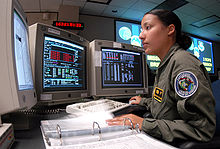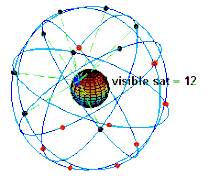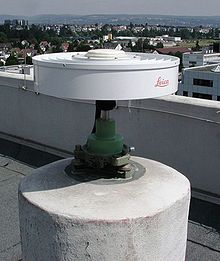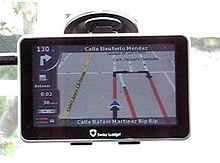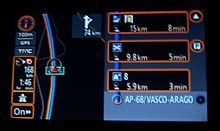GPS
The Global Positioning System (GPS; Global Positioning System), originally Navstar GPS, is a system that makes it possible to locate any object (a person, a vehicle, etc.) on Earth with an accuracy of up to centimeters (if differential GPS is used), although the common are a few meters. The system was developed, installed, and used by the United States Department of Defense, and is currently owned by the United States Space Force. To determine his position, a user uses four or more satellites and uses trilateration. It is the counterpart of the Russian GLONASS and the European Galileo.
When you want to determine the three-dimensional position, the receiver used for this automatically locates at least four network satellites, from which it receives signals indicating the identification and clock time of each of them, as well as information about the constellation. of satellites that are part of the system. Based on these signals, the device synchronizes its own clock with the GPS system time and calculates the time it takes for the signals to reach the equipment, thus measuring the distance to the satellite. Using the reverse trilateration method, it computes its own position. It is also calculated with great accuracy in time, based on the atomic clocks on board each of the satellites and on the GPS ground segment.
GPS currently has 31 operational satellites.
History
In the 1960s, the OMEGA ground navigation system, based on the phase comparison of signals emitted from pairs of ground stations, became the world's first radio navigation system. The limitations of these systems drove the need for a more universal navigation solution with more precision.
The US Navy applied this navigation technology using satellites to provide its fleet navigation systems with accurate and up-to-date position observations. The system had to meet the requirements of globality, covering the entire surface of the globe; continuity, continuous operation without being affected by atmospheric conditions; highly dynamic, to enable its use in aviation and precision. This led to producing different experiments such as Timation and the 621B system in deserts simulating different behaviors.
This is how the TRANSIT system emerged, which became operational in 1964, and by 1967 it was also available for commercial military use. TRANSIT consisted of a constellation of six satellites in low polar orbit, at an altitude of 1074 km. Such a configuration achieved global coverage, but nevertheless, the possibility of positioning was intermittent, being able to access the satellites every 1.5 hours. The calculation of the position required following the satellite for fifteen minutes continuously.
In 1967, the U.S. The Navy developed the Timation satellite, which demonstrated the feasibility of placing precise clocks in space, a technology required by GPS.
Later, in that same decade and thanks to the development of atomic clocks, a constellation of satellites was designed, each of them carrying one of these clocks and all being synchronized based on a specific time reference.
In 1973, the United States Army and Air Force programs were combined (the latter consisting of a coded transmission technique that provided precise data using a signal modulated with a PRN code (Pseudo- Random Noise: pseudo-random noise), in what became known as the Navigation Technology Program, later renamed NAVSTAR GPS.
Between 1978 and 1985, eleven NAVSTAR experimental prototype satellites were developed and launched, followed by other generations of satellites, until completing the current constellation, which was declared initially operational in December 1993 and fully operational and civil utility in April 1995.
Due to the unfortunate shooting down of Korean Air Flight 007 by the Soviet Union in 1983, with 269 fatalities, US President Ronald Reagan announced that the GPS system would be available for civilian purposes once it was completed, although the service would be offered with a precision less than that available for military services.
In 1996, recognizing the importance of civilian use of GPS, President Bill Clinton issued a directive declaring dual (military and civilian) use of GPS.
In 2009, the US government offered the standard positioning service to support ICAO's needs, and ICAO accepted the offer.
GPS Competitors
The former Soviet Union built a similar system called GLONASS, now managed by the Russian Federation.
The European Union developed the Galileo navigation system. In December 2016, the European Commission, owner of the system, reported that the Galileo navigation system began its operations and that the satellites already send positioning, navigation and time determination information to users around the world.
The People's Republic of China is implementing its own navigation system, called Beidou, which is expected to have 12 to 14 satellites between 2011 and 2015. By 2020, it should have 30 satellites fully operational. As of December 2014, they had 14 satellites in orbit.[citation needed]
Technical characteristics and benefits
The Global Navigation Satellite System is made up of:
- Satellites in constellation: 24 (4 × 6 orbits)
- Altitude: 20 200 km
- Period: 11 h 58 min (12 hours)
- Inclination: 55 degrees (respect to the ground equator).
- Useful life: 7.5 years
- Time: 1 ns
- Coverage: global
- User capacity: unlimited
- coordinate system: 8000
GPS signal
Each GPS satellite continuously broadcasts a navigation message at 50 bits per second on the microwave carrier frequency of approximately 1600 MHz. FM radio, by comparison, is broadcast at between 87.5 and 108.0 MHz and networks Wi-Fi operates at around 5,000 MHz and 2,400 MHz. More specifically, all satellites broadcast at 1,575.42 MHz (this is the L1 signal) and 1,227.6 MHz (the L2 signal).
The GPS signal provides the precise “time of week” according to the atomic clock on board the satellite, the GPS week number, and a status report for the satellite so that it can be deduced if it is faulty. Each transmission lasts 30 seconds and carries 1500 bits of encoded data. This small amount of data is encoded with a high-speed pseudorandom (PRN) sequence that is different for each satellite. GPS receivers know the PRN codes of each satellite and therefore can not only decode the signal but can distinguish it between different satellites.
Transmissions are timed to begin precisely on the minute and half minute as indicated by the satellite's atomic clock. The first part of the GPS signal tells the receiver the relationship between the satellite clock and GPS time. The following series of data provides the receiver with precise orbit information of the satellite.
Evolution of the GPS system
- Incorporation of a new L1 signal for civil use.
- Addendum to a third civil signal (L5): 1176.45 MHz
- Protection and availability of one of the two new signals for Life Security services (SOL).
- Improved signal structure.
- Increase in signal power (L5 will have a power level of –154 dB).
- Precision improvement (1-5 m).
- Increase in the number of monitoring stations: 12 (double)
- Allow better interoperability with Galileo's L1 frequency
The GPS III program pursues the goal of ensuring that GPS meets military and civilian requirements expected for the next 30 years. This program is being developed to use a three-stage approach (one of the transition stages is GPS II); very flexible, allows future changes and reduces risks. Development of GPS II satellites began in 2005, with the first of these to be available for launch in 2012, with the goal of achieving the full transition from GPS III in 2017. The challenges are as follows:
- Represent the requirements of users, both civilian and military, regarding GPS.
- Limit GPS III requirements within operational objectives.
- Provide flexibility that allows future changes to meet user requirements up to 2030.
- To provide strength for growing dependence on the determination of precise position and time as an international service.
The system has evolved and new positioning systems have been derived from it, such as dynamic positioning systems, a data capture system that allows the user to perform measurements in real time and in motion, the so-called Mobile Mapping. This system obtains 3D mobile cartography based on a device that collects a laser scanner, metric cameras, an inertial sensor (IMU), GNSS system and an odometer on board a vehicle. Great precisions are achieved, thanks to the three positioning technologies: IMU + GNSS + odometer, which working at the same time give the option of measuring even in areas where the satellite signal is not good.
Operation
The information that is useful to the GPS receiver in determining its position is called ephemeris. In this case, each satellite emits its own ephemeris, which includes the health of the satellite, its position in space, its atomic time, Doppler information, etc.
Through trilateration the position of the receptor is determined:
- Each satellite indicates that the receiver is at a point on the surface of the dial, with centre on the satellite itself and radio the total distance to the receiver.
- Obtaining information from two satellites is determined by a circle that results when the two spheres are intersected at some point where the receiver is located.
- With information from a third satellite, the inconvenience of the lack of synchronization between GPS watches and satellite watches is eliminated. And it is at this time when the GPS receiver can determine an exact 3D position (latitude, longitude and altitude).
GPS devices are incorporated into telematics to provide an optimal experience for fleet vehicle users. With this incorporation, it is possible to have a complete vision of its operation and thus be able to optimize processes.
Data reliability
Due to the military nature of the GPS system, the US Department of Defense reserved the possibility of including a certain degree of random error, which could vary from 15 to 100 m. The so-called selective availability (S/A) was removed on May 2, 2000. Although no such induced error currently applies, the intrinsic accuracy of the GPS system depends on the number of visible satellites at a given time and position. determined.
If the signal is captured from between seven and nine satellites, and if they are in a suitable geometry (they are spread out), accuracies of less than 2.5 meters can be obtained in 95% of the time. If the DGPS system called SBAS (WAAS-EGNOS-MSAS) is activated, the accuracy improves, being less than one meter in 97% of the cases. These SBAS systems are not applied in South America, since that area does not have this type of geostationary satellites. The functionality of the satellites is through position triangulation to provide the exact position of the receivers (cell phones, vehicles, etc.).
Sources of errors
The position calculated by a GPS receiver requires at the current instant the position of the satellite and the measured delay of the received signal. The accuracy is dependent on the position and delay of the signal.
By introducing the delay, the receiver compares a series of bits (binary unit) received from the satellite with an internal version using (a correlation engine hardwired into a specialized chip, based on the Gronemeyer'216 patent). When comparing series limits, electronics can set the difference to 1% of a BIT time, or approximately 10 nanoseconds per C/A code. Since then, GPS signals have propagated at the speed of light, which represents an error of 3 meters. This is the minimum possible error using only the GPS C/A signal.
Position accuracy is improved with a P(Y) signal. Assuming the same accuracy of 1% of BIT time, the P(Y) (high frequency) signal results in an accuracy of plus or minus 12 inches. Errors in the electronics are one of several reasons that impair accuracy (see table).
The accuracy of even standard (non-military) GPS receivers can also be improved using software and real-time techniques. This has been put to the test on a global navigation satellite system (GNSS) such as NAVSTAR-GPS. The proposal was based on the development of a precision relative positioning system equipped with low-cost receivers. The contribution was given by the development of a methodology and techniques for the treatment of information that comes from the receivers.
| Source | Effect |
|---|---|
| Ionosfera | ± 3 m |
| Efemérides | ± 2.5 m |
| Satellite watch | ± 2 m |
| Multiband distortion | ± 1 m |
| Troposfer | ± 0.5 m |
| Numerical errors | ± 1 m or less |
- Delay of the signal in the ionosphere and the troposphere.
- Multi-ruta signal, produced by the rebound of the signal in nearby buildings and mountains.
- Orbital errors, where satellite orbit data are not completely accurate.
- Number of visible satellites.
- Geometry of visible satellites.
- Local errors on the GPS watch.
Factors Affecting Data Quality:
Own Satellite Errors.
Refers to the errors that affect the quality of the results obtained in a GPS measurement.
Orbital errors (ephemeris): Because satellites do not follow a normal Keplerian orbit due to perturbations, better orbit estimators are required, a process that is hampered by insufficient knowledge of the forces acting on them. the satellites. These errors affect the determination of the satellite's position at a given instant with respect to a selected reference system. To reduce the error, instead of using the ephemeris captured in the receiver, precise ephemeris calculated by the IGS and NASA days after the measurement are used.
Clock errors: They refer to variations in the satellite clock time system, produced by the drift of the oscillators and those caused by the action of relativistic effects. These errors lead to the existence of a differential between the satellite time system and the GPS system, which will not be constant for all the satellites but rather varies from one to the other, due to the fact that the standard frequency of the oscillators of the satellites has defined values for each satellite.
Errors of the geometric configuration: the uncertainties in a positioning are consequence of the errors of the distances associated with the geometries of the satellites used, four or more. The effect of the geometry is expressed by the parameters of the so-called Geometric Dilution of Precision (GDOP), which considers the three three-dimensional position and time parameters. The GDOP value is a composite measure that reflects the influence of the satellite constellation on the combined precision of the estimates of a station's time and position.
For this purpose, the following are considered: PDOP: Dilution of precision for the position. HDOP: Dilution of Precision for Position. VDOP: Vertical Dilution of Precision. TDOP: Time Dilution of Precision.
Errors from the propagation medium.
Ionospheric refractive errors: At the GPS frequency, the range of the refractive error in the ionosphere goes from 50 meters (maximum, at noon, a satellite near the horizon) to 1 meter (minimum, at night, a satellite at the zenith). Because ionospheric refraction is frequency dependent, the effect is estimated by comparing measurements made at two different frequencies (L1=1575.42 MHz. and L2=1227.60 MHz.). Using two stations, one with known coordinates. We can correct timing errors. The travel time delay in the ionosphere depends on the electron density along the signal path and the frequency of the signal. An influential source on the density of electrons is the solar density and the earth's magnetic field. Therefore the ionospheric refraction depends on the time and the measurement site.
Tropospheric refractive errors: Tropospheric refraction produces errors between 2 meters (satellite at zenith) and 25 meters (satellite at 5° elevation). Tropospheric refraction is independent of frequency, therefore a two-frequency measurement cannot determine the effect but this error can be compensated for using tropospheric models.
Multipath: It is the phenomenon in which the signal arrives by two or more different paths. The difference in the path lengths causes interference of the signals when they are received. Multipath is usually noticed when measuring near reflective surfaces, to minimize its effects an antenna capable of discriminating against signals arriving from different directions is used.
Reception errors.
These errors depend on both the measurement mode and the type of receiver being used.
Noise: As the standard deviation of the noise in the measurement is proportional to the wavelength in the code. The noise in the carrier phase measurements determines the amount of data and the tracking time required to reach a certain level of precision, continuous measurement and monitoring being crucial to ensure such precision.
Antenna phase center: This can change depending on the elevation angle of the azimuth (figure 15). The apparent electrical phase center of the GPS antenna is the precise navigation point for relative work. If the antenna phase center error is common for all points during the measurement, they cancel. In relative measurements, all the antennas of the network are aligned in the same direction (usually magnetic north) so that the movement of the antenna's phase center is common and cancels with a first approximation.
DGPS or differential GPS
DGPS (Differential GPS), or Differential GPS, is a system that provides GPS receivers with corrections to the data received from GPS satellites, in order to provide greater precision in the calculated position. It was conceived primarily due to the introduction of selective availability (SA).
The foundation lies in the fact that the errors produced by the GPS system affect the receivers located close to each other equally (or in a very similar way). The errors are strongly correlated in the near receivers.
A GPS receiver fixed on the ground (reference) that knows exactly its position based on other techniques, receives the position given by the GPS system, and can calculate the errors produced by the GPS system, comparing it with its own, known in advance. This receiver transmits the error correction to the receivers close to it, and thus these can, in turn, also correct the errors produced by the system within the signal transmission coverage area of the reference GPS equipment.
In short, the DGPS structure would be as follows:
- Monitoring station (reference), which knows its position with very high precision. This station is composed of:
- A GPS receiver.
- A microprocessor, to calculate the errors of the GPS system and to generate the structure of the message that is sent to the receivers.
- Transmitter, to establish a unidirectional data link to end-user receivers.
- User equipment, composed of a DGPS receiver (GPS + data link receiver from the monitored station).
There are several ways to obtain DGPS corrections. The most used are:
- Received by radio, through some channel prepared for it, such as the RDS on an FM radio station.
- Internet downloads, or with a wireless connection.
- Provided by some satellite system designed for that purpose. In the United States there is WAAS, in Europe the EGNOS and in Japan the MSAS, all compatible with each other.
Two types of corrections can be included in messages sent to nearby recipients:
- A correction directly applied to position. This has the inconvenience that both the user and the station monitors should use the same satellites, as the corrections are based on those same satellites.
- A correction applied to the pseudodistances of each of the visible satellites. In this case the user will be able to make the correction with the four satellites of better signal-ruid ratio (S/N). This correction is more flexible.
The error caused by selective availability (SA) varies even faster than the data rate. For this reason, together with the correction message that is sent, the validity time of the corrections and their trends are also sent. Therefore, the receiver must do some kind of interpolation to correct the errors produced.
If it is desired to increase the coverage area of DGPS corrections and, at the same time, minimize the number of fixed reference receivers, it will be necessary to model the spatial and temporal variations of the errors. In such a case we would be talking about wide area differential GPS.
With DGPS, errors due to:
- Selective availability (eliminated from 2000).
- Propagation for ionosphere - troposphera.
- Errors in satellite position (efemérides).
- Errors caused by problems in the satellite clock.
For DGPS corrections to be valid, the receiver has to be relatively close to some DGPS station; Generally, less than 1000 km. The precisions that differential receivers handle are centimeters, so they can be used in engineering. It makes it possible to determine the position of an object, a person or a vehicle worldwide with a precision of up to centimeters.
Basic vocabulary in GPS
- BRG (bearing): Rumbo estimated between two reference points (waypoints)
- CMG (Course Made Good): between the starting point and the current position
- EPE (Estimated Position Error): error margin estimated by the receiver
- ETE (Estimated Time Enroute): Estimated time between two waypoints
- DOP (Dilution of Precision): measurement of the accuracy of the coordinates obtained by GPS, according to the distribution of the satellites, availability of them...
- ETA (Estimated Time to Arrival): estimated time of arrival at destination
Integration with mobile telephony
Currently within the mobile phone market the trend is for manufacturers to integrate GPS technology into their devices. The use and widespread use of GPS is particularly widespread in mobile phones, smartphones, which has given rise to an entire ecosystem of software for this type of device, as well as new business models that range from the use of the mobile terminal for navigation traditional point-to-point to the provision of so-called Location Based Services (LBS).
A good example of the use of GPS in mobile telephony are applications that allow you to know the position of nearby friends on a base map. To do this, it is enough to have the respective application for the desired platform (Android, Bada, IOS, WP, Symbian) and allow yourself to be located by others.
Integration with smart watches
New trends in the world of fitness, sports and leisure have led to the appearance of smartwatches with GPS capabilities, there are different types of wearable technology devices that use GPS and usually work in combination with the smartphone, if used It deals with devices without screens such as sports watches from brands such as Garmin with its Forerunner or Polar range and smart bracelets such as those of Xiaomi or independently in smart watches such as the Apple Watch or the Samsung Gear S3.
As with smartphones, utilities are applications that allow you to know the position of nearby friends on a base map or follow the route taken. To do this, it is enough to have the respective application for the desired platform (Android, Bada, IOS, WP, Symbian). Some apps do not require connecting to the smartphone and provide details independently on the device screen.
GPS and the theory of relativity
The clocks in GPS satellites require synchronization with those located on the ground, for which the general theory of relativity and the special theory of relativity must be taken into account. The three relativistic effects are: time dilation, gravitational frequency shift, and eccentricity effects. The relativistic slowdown of time due to the speed of the satellite is about 1 part in 1010, gravitational time dilation causes the satellite clock to rotate about 5 parts in 1010 faster than an Earth-based clock, and the Sagnac effect due to rotation relative to receivers on Earth. If the effect of the speed of the satellite and its gravity with respect to an observer on the ground were not taken into account, a shift of 38 microseconds per day would be produced, which in turn would cause errors of several kilometers in the determination of the position.
Special and general relativity
According to the theory of relativity, due to its constant movement and relative height regarding, approximately, a non-revolving inertial reference frame focused on the Earth, the satellite watches are affected by their speed. The special relativity predicts that the frequency of atomic clocks moving at GPS orbital speeds, some v = 4 km/s, marking more slowly than fixed ground clocks in a factor of v22c2≈ ≈ 10− − 10{displaystyle {frac {v^{2}}{2c^{2}}}}{approx 10^{}{}{ex}}, or result in a delay of about 7 μs/day, being c = speed of light in the vacuum.
The effect of gravitational frequency shift on GPS, general relativity predicts that a clock closer to a massive object will be slower than a clock further away. Applied to GPS, the receivers are much closer to Earth than the satellites, making GPS clocks faster by a factor of 5 × 10 -10, or about 45.9 μs/ day.
By combining time dilation and gravitational frequency shift, the discrepancy is approximately 38 microseconds per day, a difference of 4.465 parts of 1010. Uncorrected, errors in pseudorange initial would accumulate approximately 10 km / day. This error in the initial pseudorange is corrected in the process of solving the navigation equations. Furthermore, the orbits of the satellites are elliptical, rather than perfectly circular, which causes the effects of time dilation and gravitational frequency shift to vary with time. This eccentricity effect causes the clock speed difference between a GPS satellite and a receiver to increase or decrease depending on the altitude of the satellite.
To compensate for this discrepancy, the frequency standard aboard each satellite is given an offset rate before launch, so it runs slightly slower than the working frequency on Earth. Specifically, it works at 10.22999999543 MHz instead of 10.23 MHz Since the atomic clock on board GPS satellites is precisely set, it makes the system a practical application of the scientific theory of relativity in a one world environment. real. Friedwardt Winterberg proposed placing atomic clocks on artificial satellites to test Einstein's general theory in 1955.
Sagnac distortion
GPS observation processing must also compensate for the Sagnac effect. The GPS time scale is defined in an inertial frame, but observations are processed in an Earth-centered, Earth-fixed (co-rotating) frame, a frame in which simultaneity is not uniquely defined. A Lorentz transformation is applied, then, to convert from the inertial system to the ECEF system. The resulting time correction signal path has opposite algebraic signs of the satellites in the eastern and western celestial hemispheres. Ignoring this effect will result in an east-west error on the order of hundreds of nanoseconds, or tens of meters from your position.
Applications
Civilians
- Land navigation (and pedestrian), sea and air. A lot of cars currently incorporate it, being of particular use to find directions or indicate the situation to the crane.
- Mobile phones
- Topography and geodesy.
- Construction (Overgrounds, cuts, pipes, etc.).
- Agricultural location (a)precision agriculture), cattle rancher and fauna.
- Salvage and rescue.
- Sport, camping and leisure.
- A.P.R.S. Application similar to fleet management, in open mode for amateurs
- For locating the sick, the disabled and the minors.
- Scientific applications in field works (see geomatic).
- Geocaching, sporting activity consisting of looking for "treasures" hidden by other users.
- For vehicle tracking and recovery.
- Sport navigation.
- Air sports: paragliding, can wing, planners, etc.
- There is one who draws using tracks or plays using the motion as a cursor (common on the Garmin GPS).
- Fleet management systems.
Military
- Land, air and sea navigation.
- Guided missiles and missiles of various kinds.
- Search and rescue.
- Recognition and cartography.
- Detection of nuclear detonations.
Contenido relacionado
Port
Enhanced Data Rates for GSM Evolution
Computer scanner


